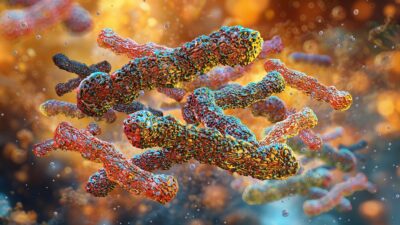Senescent Cells Harm Muscle Regeneration in Mice
- This goes against other research that shows a beneficial effect.

New research published in Nature has shown that senescent cells hamper muscle regeneration through inflammation and fibrosis [1].
Cellular senescence is one of the hallmarks of aging. However, there is a growing understanding that, just like aging itself, senescence is a complex and heterogeneous phenomenon [2]. Senescent phenotypes differ considerably depending on what causes them and in what tissue and cell type they occur. This heterogeneity makes it harder to devise therapies against senescence, so numerous attempts are underway to improve our understanding of cellular senescence, including the vast NIH initiative SenNet. This research contributes to those efforts by studying cellular senescence in the context of muscle injury and regeneration.
Both different and alike
One of the problems with studying senescent cells in vivo is that they are scarce. Both in young (3- to 6-month) and very old (28-month) mice, the established senescence markers p16 and beta-galactosidase (β-gal) were undetectable in resting muscles. However, both signals were greatly increased three days after the researchers simulated muscle injury by injecting cardiotoxin. These markers were both more abundant and more persistent in the muscles of old mice, which correlates with their slower recovery. Transient accumulation of senescent cells in both groups was confirmed by additional markers. The researchers also found p16- and β-gal-positive cells in biopsy samples of injured human muscles.
Many of the cell types found in muscles had senescent counterparts. The researchers were able to isolate these cells and perform single-cell RNA analysis, which revealed 16 upregulated and 33 downregulated genes common to most of them. Inflammatory and fibrotic/matrix-remodeling factors were among the most upregulated. However, senescent cells of various types were closer in their proteomes to non-senescent cells of the same type than to each other. On the other hand, senescent cells were also quite distinct from their non-senescent counterparts, with about 2,000 to 5,000 differentially expressed genes, depending on the cell type, with little overlap. This confirms that although senescent cells share some characteristics, senescence is also specific to cell types.
Senescent cells hamper muscle regeneration
The researchers then analyzed the role of senescent cells in muscle regeneration. In muscles treated with ganciclovir, which decreases senescence, they observed better regeneration along with reduced fibrosis and inflammation. Treatment with the popular senolytic duo dasatinib + quercetin (D+Q) produced similar results. On the other hand, transplantation of senescent cells, but not of non-senescent cells of the same type, into a healing muscle hampered regeneration. Specifically, the presence of senescent cells blunted stem cell proliferation required for muscle regeneration.
Senescent cells proved detrimental to muscle regeneration in both young and old mice. The researchers note that this goes against the popular theory that senescent cells play a beneficial role in wound healing, at least in younger bodies [3]. Therefore, this finding warrants further investigation.
Blocking a SASP component mitigates the damage
Senescent cells are characterized by the senescence-associated secretory phenotype (SASP). However, this cocktail of molecules, largely considered detrimental to neighboring cells, can be very diverse. In this study, depending on cell type and conditions, the number of SASP components ranged from 78 to 363. Despite this heterogeneity, in all senescent cells, pathway enrichment identified two major functions of SASP: inflammation, including lipoprotein remodeling and TNF/NF-κB signaling, and fibrosis, including matrix organization, collagen metabolism, and TGFβ signaling.
The researchers also found a striking similarity between inflammation profiles of young injured tissues, old healthy tissues, and senescent cells. Their takeaway is that “the SASP of senescent cells, transiently present in injured young muscles, mimics inflammaging, which is exacerbated in injured aged muscle.” Further analysis of the SASP revealed that it activated downstream signaling pathways in receiving non-senescent cells, inhibiting cell cycle and proliferation.
Among SASP elements common for senescent cells of all types, the protein C36 caught the scientists’ attention, because a computer-generated C36 signaling network predicted that it might be an important SASP regulator. CD36 blockade in injured muscles did not affect the number of senescent cells but reduced the levels of several SASP proteins. It also improved regeneration in both young and old muscles, reduced inflammation and fibrosis, and boosted muscle strength.
After CD36 production was blocked in senescent cells in vitro, transplantation of such cells did not hamper muscle regeneration. CD36 blockade also eliminated the negative effect of senescent cells on the proliferation of co-cultured stem cells in vitro.
Conclusion
This study shows that while senescent cells are indeed quite heterogeneous, there are also some common pathways that can be targeted to counteract those cells’ negative effects on aged tissues. It also highlights the role of senescent cells in inflammation and fibrosis, two major drivers of aging and age-related diseases. Interestingly, the results challenge the existing dogma that at least in young tissues, senescent cells play a positive role in wound healing.
Literature
[1] Moiseeva, V., Cisneros, A., Sica, V., Deryagin, O., Lai, Y., Jung, S., … & Muñoz-Cánoves, P. (2022). Senescence atlas reveals an aged-like inflamed niche that blunts muscle regeneration. Nature, 1-10.
[2] Kirschner, K., Rattanavirotkul, N., Quince, M. F., & Chandra, T. (2020). Functional heterogeneity in senescence. Biochemical Society Transactions, 48(3), 765-773.
[3] Moiseeva, V., Cisneros, A., Cobos, A. C., Tarrega, A. B., Oñate, C. S., Perdiguero, E., … & Muñoz‐Cánoves, P. (2022). Context‐dependent roles of cellular senescence in normal, aged, and disease states. The FEBS







